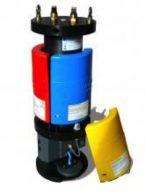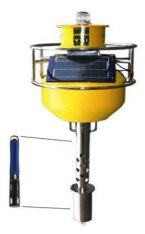HAB Testing and Prevention
OWLA has identified testing and prevention technologies that can help detect and deter HABs.
Technologies to Consider
In the late Summer months, Owasco Lake will likely experience yet another outbreak of Harmful Algal Blooms (HABs). Whether you live on the shore of the Lake, drive by it, like to swim in it, picnic by it, boat on it, drink its water, or just live in the region, our lives, our jobs, and our economic well-being are directly influenced by the health or ill-health of this Finger Lake.
These bacteria proliferate during the hot, calm days of August into October, turning our Lake into an ugly, keep-away green. Even worse, as the bacteria die they often release poisons that can have very serious health effects. Scientists around the world are working hard to come up with solutions. About the only fix now known is to greatly reduce the phosphorus and nitrogen getting into the lake.
However, the bacteria have a weakness. They like calm, clear, warm water. There is an early body of research that suggests that perhaps we can inhibit their normal pattern by mixing up the water column; i.e., make it more turbulent and less calm.
OWLA is currently working with the Owasco Lake Water Quality Management Council, the Finger Lakes Institute and the NYSDEC to identify, research and test a number of possible technologies directed a minimizing HAB outbreaks.
Leading the research is Dr. John Halfman, Professor of Geolimnology & Hydrogeochemistry, Department of Geoscience & Environmental Studies Program, Finger lakes Institute. Several lake front homeowners have agreed to participate in this research project.
Current plans are to secure a quantity of two types of water mixers. One type will be for lakeshore sites that have a depth of 15 to 20 feet within 75 feet of the shore line. The other type is for more shallow, near shore locations. This type typically mounts under a dock. It is the same mixer as is used to prevent ice from forming around a dock or boat lift. We will also be testing a promising Ultrasound technology.
Examples of some of the technologies that were considered are shown below. The technologies to be utilized in this initial research are:
• Airmax PS-20 that is designed for use in deep water
• Airmax SW-20 that is designed for use in shallow water
• Diversified Power International Quattro-DB Ultrasound
At the end of the year all research will be evaluated, next steps determined and the results shared with the participating home owners, OWLA members and with the community.
Our thanks to the homeowners who have agreed to participate in this important research project.
Testing
Phosphate Sensors
Phosphate sensors are available for shallow water tributary testing to detect periodic phosphate levels which identify high nutrient conditions. Seabird Scientific provides the HydroCycle-PO4, which is designed for environmental monitoring. More information can be found at: http://www.seabird.com/hydrocycle

Intelligent Buoys
Intelligent Buoys with sensors can be deployed in the lake at locations where nutrient loads and HABs can occur. They can transmit their scientific data to provide important information that can notify when conditions leading to a bloom develop. Xylem Corporation produces a rugged buoy with sensors to test for algae and nutrients. Follow the link below for more information: https://www.ysi.com/EMM150

Prevention
Ultrasound
Ultrasound is used to deter HABs using low power sound waves above human hearing range. The waves are transmitted below the water surface to create a barrier that prevents bacteria and algae growth. An ultrasound device can extend to a maximum of 1500 feet in diameter to be placed near shore or on a buoy platform. A device can be powered from land or by solar buoy. Please use the links below for product information:
http://www.dpipower.com/store/index.php/hbs.html
https://www.lgsonic.com/algae-biofouling-control-products

Aeration
Aeration effectively reduces algae by putting more oxygen into a water body causing beneficial bacteria to consume extra nutrients. Aeration also moves the water to reduce stagnation. Several different aeration approaches are available such as bubblers, mixers and bottom diffusers. OWLA has found that the bottom aeration is most practical for cost, maintenance and effectiveness. Bottom aeration uses an underwater diffuser unit with an air compressor on land to move air up the water column extending several acres. The following manufacturers provide a variety of sizes:
https://kascomarine.com/products/diffusers/robust-aire
http://www.airmaxeco.com/pond-lake-aeration

Circulators/Mixers
Circulators/Mixers are used to move water around docks. Although this does not directly prevent algae, it can produce water conditions that may prevent a small area around a dock from stagnant turbid water. These require electrical power and can be attached under a structure such as a dock or float. See the following link for manufacturer information:
https://kascomarine.com/products/water-circulators/circulators-mixers

Floating Wetlands
Floating Wetlands are man made constructed platforms ranging from a small raft to a acre system. These are designed to hold plants that consume the nutrients from the water and making it less likely to support algae blooms.

Run off into the lake
Latest technologies are applied to help find candidate runoff “hotspots” in a watershed including the more than 200 square miles of watershed draining into Owasco Lake. These technologies include air and water drone-mounted sensors and GIS applications that combine key factors such as slope, soil types, and land use. Hotspots are visited by the collaborating investigators with participation of the land owner(s) to observe first-hand what is happening. This is followed by identification of the most suitable corrective best management practices, site specific designs, and implementation at sites that are accessible and for which the landowners grant access permission.

An example of watershed stream bank stabilization

Firelane 23 Owasco Lake ditch lined with rock (Funding provided by Auburn Fox Toyota)

Hydroseeding to prevent erosion (Photo from Albany Soil and Water Conservation District)
What can you do to HELP?
Protecting Owasco Lake is essential to the maintenance of our community character and the improvement of our economic future. We encourage everyone to help the Owasco Watershed Lake Association personally and/or financially. By this commitment you will help keep Owasco Lake clean and safe.